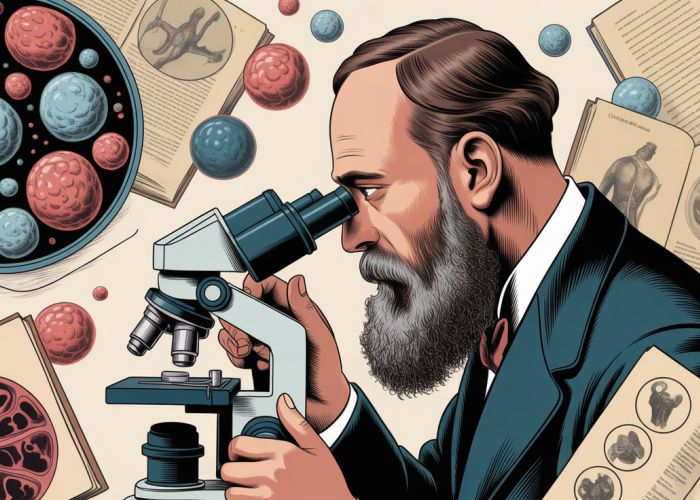Rudolf Virchow’s discovery fundamentally reshaped our understanding of life’s building blocks, influencing medical science profoundly. Cell Theory, a cornerstone of modern biology, underwent significant refinement through Virchow’s groundbreaking work. The Charité Hospital in Berlin, a major center for medical research, provided Virchow with a critical environment for his studies and experiments. His work significantly impacted the field of Pathology, shifting the focus towards cellular origins of disease. Understanding the context surrounding rudolf virchow discovery, therefore, requires acknowledging these interconnected entities.

Structuring "Virchow’s Discovery: How Cell Theory Revolutionized Medicine"
To effectively explain how Rudolf Virchow’s work transformed medicine within the context of cell theory, a well-structured article focusing on "rudolf virchow discovery" is crucial. The layout below outlines a clear, informative, and analytical approach.
Introduction: Setting the Stage
- Hook: Begin with a compelling anecdote or historical event illustrating the state of medicine before cell theory and Virchow’s contribution. Emphasize the lack of understanding regarding disease origins.
- Brief Overview of Pre-Cellular Biology: Touch upon previous theories about the body, such as humoralism, and how they were inadequate in explaining disease processes.
- Introducing Cell Theory: Briefly define cell theory’s fundamental tenets (Schleiden & Schwann’s contributions).
- Thesis Statement: Clearly state the article’s purpose: to explain how "rudolf virchow discovery" and his contributions to cell theory revolutionized medical understanding and practice.
Understanding Cell Theory
- Key Principles of Cell Theory:
- All living organisms are composed of one or more cells.
- The cell is the basic structural and functional unit of life.
- All cells arise from pre-existing cells.
- Importance of the Microscope: Briefly mention the role of microscope technology in advancing cellular studies.
Rudolf Virchow’s Groundbreaking Work: "Omnis Cellula e Cellula"
- Virchow’s Biography (Brief): Include key details relevant to his scientific career and intellectual influences. Focus on his medical training and early research.
- "Omnis Cellula e Cellula" – The Core Discovery:
- Explain the meaning of "Omnis Cellula e Cellula" ("All cells come from cells").
- Detail the observations and evidence Virchow used to support this principle.
- Virchow’s Challenges to Spontaneous Generation: Emphasize how his work directly refuted the concept of spontaneous generation, further solidifying cell theory.
- Context of Virchow’s Findings: Describe the scientific landscape at the time and why his work was revolutionary.
Virchow’s Contributions to Pathology
- Cellular Pathology: A New Paradigm: Explain how Virchow’s application of cell theory to pathology transformed the understanding of disease.
- How Disease Originates at the Cellular Level:
- Provide examples of how Virchow demonstrated that diseases are caused by alterations in cells, not simply imbalances of humors or other vague forces.
- Discuss specific diseases (e.g., leukemia) and how Virchow connected their origins to cellular abnormalities.
- Virchow’s Focus on Tissue Analysis: Highlight his development and refinement of microscopic tissue analysis techniques.
Impact on Medical Practice and Research
- Diagnostics: Explain how Virchow’s cellular pathology influenced diagnostic methods.
- Biopsy: How cellular examination of biopsies became crucial for diagnosis.
- Autopsy: How systematic cellular analysis during autopsies improved understanding of disease progression and cause of death.
- Treatment Strategies: Discuss how understanding disease at the cellular level opened new avenues for treatment development.
- Further Research: How Virchow’s work paved the way for future research areas like:
- Cancer biology
- Immunology
- Genetics
Virchow’s Legacy and Controversy
- Recognition and Influence: How Virchow became a highly respected figure in medicine and science.
- Points of Debate & Controversy:
- Acknowledge any controversies surrounding his work or interpretations of his findings. For example, his potential attribution issues concerning Robert Remak’s earlier work.
- Enduring Impact: Summarize the long-lasting significance of "rudolf virchow discovery" and cellular pathology on modern medicine.
Supplementary Materials (Optional)
- Timeline: A timeline visually representing the key events in Virchow’s life and the development of cell theory.
- Images: Microscopic images of healthy and diseased cells to illustrate the principles of cellular pathology.
- Diagrams: Visual representations of cellular processes.
This structured layout ensures a comprehensive and informative exploration of "rudolf virchow discovery" and its profound impact on the field of medicine. The focus remains on explaining the core concepts in a clear and accessible manner.
FAQs: Virchow’s Cell Theory and Medical Revolution
Here are some frequently asked questions to help clarify the significance of Virchow’s discovery and the impact of cell theory on medicine.
What exactly was Virchow’s key contribution to cell theory?
While not the first to propose cell theory, Rudolf Virchow’s discovery famously stated "Omnis cellula e cellula," meaning all cells arise from pre-existing cells. This completed the cell theory, establishing that new cells don’t spontaneously generate, fundamentally changing our understanding of disease origins.
How did Rudolf Virchow’s discovery impact the understanding and treatment of disease?
Virchow’s work shifted the focus of disease from the body’s overall humors to the cellular level. This meant diseases were now viewed as malfunctions of cells, leading to advancements in diagnosis, like biopsies, and new treatment strategies that targeted cellular processes.
Why is Virchow’s contribution considered revolutionary to medicine?
The cellular theory provided a new framework for understanding health and disease, revolutionizing the way doctors approached diagnosis, pathology, and treatment. Without Rudolf Virchow discovery and his cell theory, modern medicine would be unrecognisable. It laid the groundwork for understanding cancer, genetic disorders, and infectious diseases on a fundamental level.
What are some examples of medical advancements made possible by cell theory?
The understanding that diseases originate at the cellular level has enabled advancements such as targeted drug therapies, personalized medicine based on genetic information, and sophisticated diagnostic tools like flow cytometry. All are based on Rudolf Virchow discovery that cells are the fundamental unit of life.
So, there you have it! Rudolf Virchow discovery is a real game-changer when it comes to understanding how the body works. Hopefully, this article cleared things up a bit and gave you a new appreciation for those tiny cells!